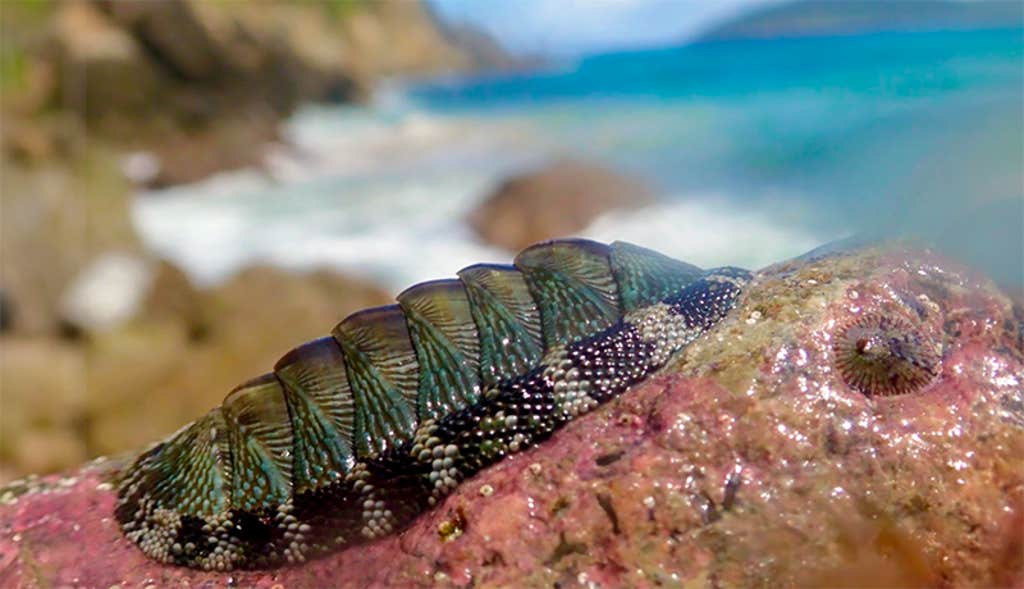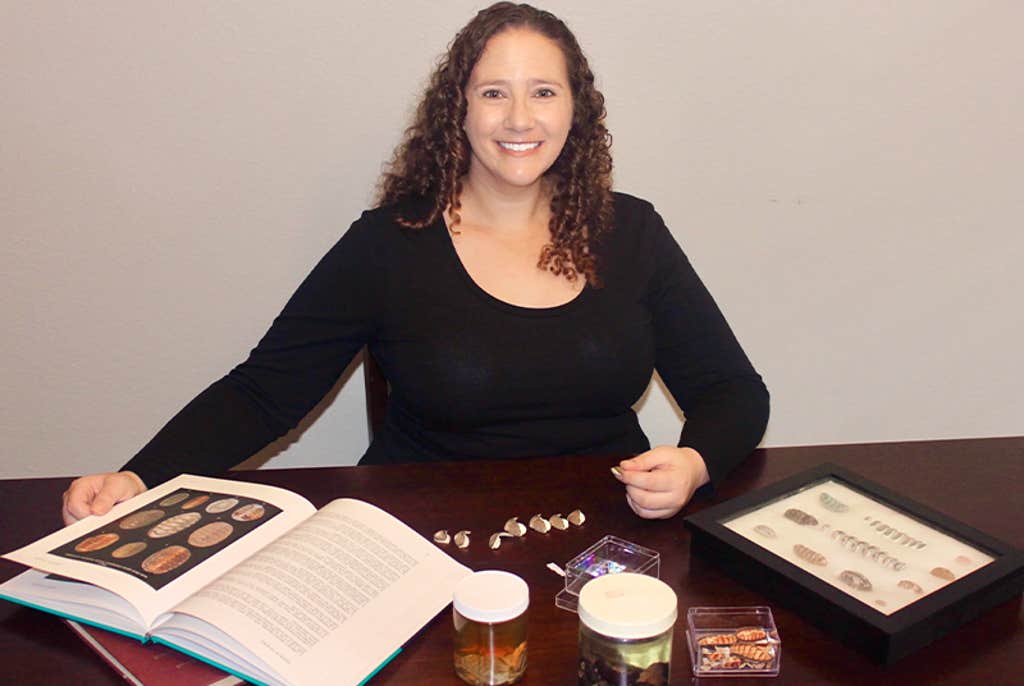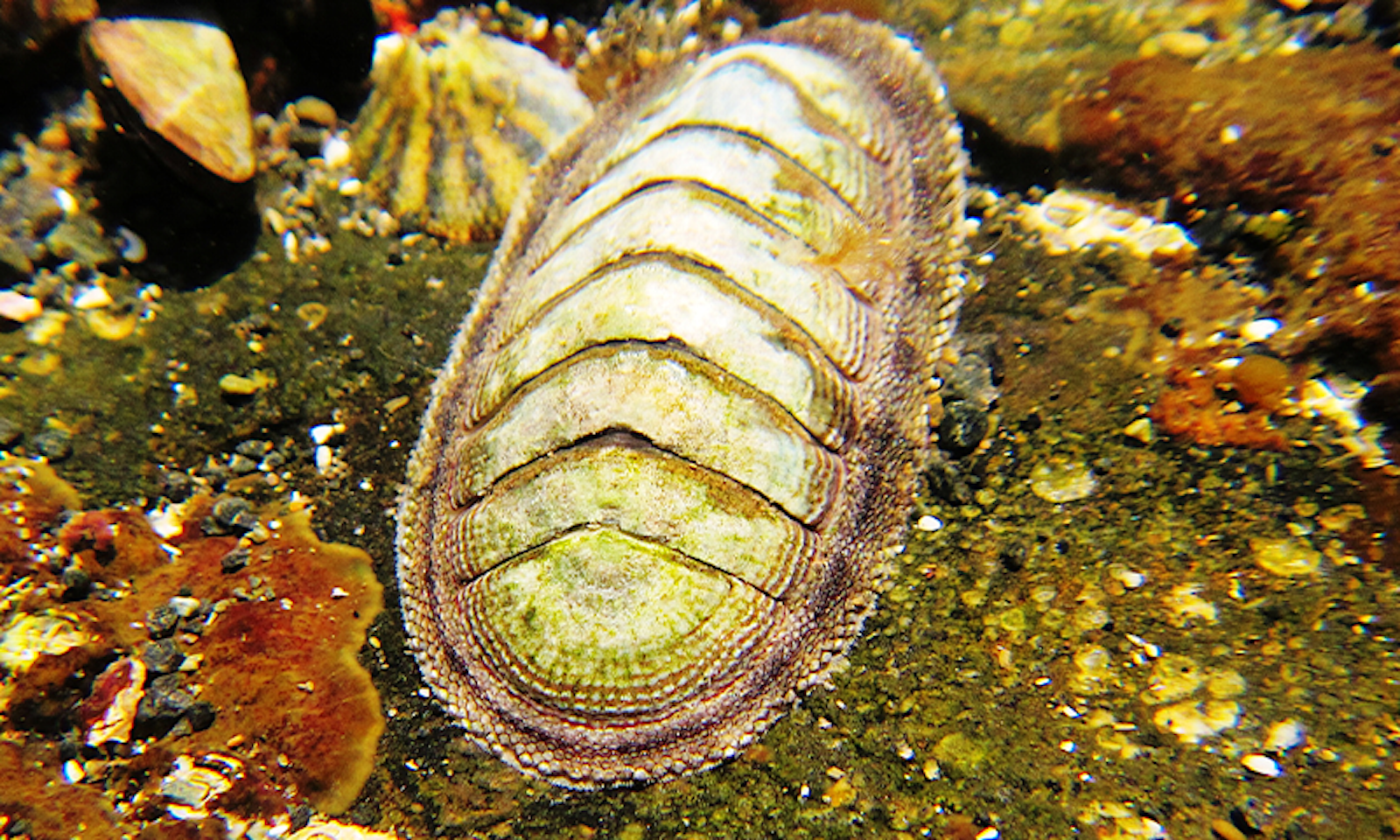Biologists have often wondered what would happen if they could rewind the tape of life’s history and let evolution play out all over again. Would lineages of organisms evolve in radically different ways if given that opportunity? Or would they tend to evolve the same kinds of eyes, wings, and other adaptive traits because their previous evolutionary histories had already sent them down certain developmental pathways?
A new paper published in Science this February describes a rare and important test case for that question, which is fundamental to understanding how evolution and development interact. A team of researchers at the University of California, Santa Barbara happened upon it while studying the evolution of vision in an obscure group of mollusks called chitons. In that group of animals, the researchers discovered that two types of eyes—eyespots and shell eyes—each evolved twice independently. A given lineage could evolve one type of eye or the other, but never both.
Independently, chitons evolved eyes four times, which is really impressive.
Intriguingly, the type of eye that a lineage had was determined by a seemingly unrelated older feature: the number of slits in the chiton’s shell armor. This represents a real-world example of “path-dependent evolution,” in which a lineage’s history irrevocably shapes its future evolutionary trajectory. Critical junctures in a lineage act like one-way doors, opening up some possibilities while closing off other options for good.
“This is one of the first cases [where] we’ve actually been able to see path-dependent evolution,” said Rebecca Varney, a postdoctoral fellow in Todd Oakley’s lab at UCSB and the lead author of the new paper. Although path-dependent evolution has been observed in some bacteria grown in labs, “showing that in a natural system was a really exciting thing to be able to do.”
“There’s always an impact of history on the future of a particular trait,” said Lauren Sumner-Rooney, who studies invertebrate visual systems at the Leibniz Institute for Evolution and Biodiversity Science and was not involved in the new study. “What’s particularly interesting and exciting about this example is that the authors seem to have pinpointed the moment in time where you get that split.”
For that reason, the chitons “are likely to enter future textbooks on evolution” as an example of path-dependent evolution, said Dan-Eric Nilsson, a visual ecologist at Lund University in Sweden who was not involved in the research.
Chitons, small mollusks that live on intertidal rocks and in the deep sea, are like little tanks protected by eight shell plates—a body plan that’s remained relatively stable for some 300 million years. Far from being inert armor, these shell plates are heavily decorated with sensory organs that enable the chitons to detect possible threats.

The sensory organs come in three types. All chitons have aesthetes, a wildly synesthetic all-in-one receptor that enables them to sense light as well as chemical and mechanical cues in the environment. Some chitons also have proper visual systems: either thousands of light-sensing eyespots or hundreds of more complex shell eyes, which have a lens and retina for capturing rough images. Animals with shell eyes can detect looming predators, in response to which they clamp themselves tightly onto the rock.
To understand how this variety of chiton eyes evolved, a team of researchers led by Varney looked at how hundreds of chiton species are related. They used a technique called exome capture to sequence strategic sections of DNA from old specimens in the collection of Doug Eernisse, a chiton specialist at California State University, Fullerton. All told, they sequenced DNA from more than 100 species carefully selected to represent the full breadth of chiton diversity, assembling the most comprehensive phylogeny (or tree of evolutionary relationships) for chitons to date.
Then the researchers mapped the different eye types onto the phylogeny. The first step before evolving either shell eyes or eyespots, the researchers observed, was an increase in the density of aesthetes on the shell. Only then could more complex eyes appear. Eyespots and shell eyes each evolved two separate times across the phylogeny—representing two separate instances of convergent evolution.
“Independently, chitons evolved eyes—and, through them, what we think is likely something like spatial vision—four times, which is really impressive,” Varney said. “They also evolved that incredibly quickly.” The researchers estimated that in the neotropical genus Chiton, for example, the eyespots evolved within just 7 million years—a blink of an eye in evolutionary time.
The results surprised the researchers. “I was thinking that it was a stepwise evolution in complexity, going from the aesthetes to an eyespot system to the shell eyes—a very satisfying progression,” said Dan Speiser, a visual ecologist at the University of South Carolina and a paper co-author. “Instead, there are multiple paths toward vision.”
But why did some lineages evolve shell eyes rather than eyespots? During a six-hour drive from a conference in Phoenix back to Santa Barbara, Varney and Oakley started to develop the hypothesis that the number of slits in a chiton’s shell could be key to the evolution of chiton vision.

All light-sensing structures on the chiton shell, Varney explained, are attached to nerves, which pass through the shell slits to connect to the body’s main nerves. The slits function as cable organizers, bundling sensory neurons together. More slits mean more openings through which nerves can run.
It so happens that the number of slits is standard information that is recorded anytime somebody describes a new chiton species. “The information was out there, but without the context of a phylogeny to map it back to, it didn’t have any meaning,” Varney said. “So I went and looked at this and started seeing this pattern.”
Varney saw that twice, independently, lineages with 14 or more slits in the head plate evolved eyespots. And twice, independently, lineages with 10 or fewer slits evolved shell eyes. She realized that the number of slits locked into place which kind of eye type could evolve: A chiton with thousands of eyespots needs more slits, whereas a chiton with hundreds of shell eyes needs fewer. In short, the number of shell slits determined the evolution of the creatures’ visual systems.
As a chiton, “you might start life with 10 eyes and finish your life with 200 eyes.”
The findings lead to a new set of questions. One that the researchers are actively investigating is why the number of slits constrains the type of eye that can evolve. Answering that will require work to elucidate the circuitry of the optic nerves and how they process signals from hundreds or thousands of eyes.
Alternatively, the relationship between eye type and the number of slits might be driven not by the needs of vision but by the way the plates develop and grow in different lineages, Sumner-Rooney suggested. Shell plates grow from the center outward by accretion, and eyes are added throughout the chiton’s life as the edge grows. “The oldest eyes are those in the middle of the animal, and the most recently are added at the edges,” Sumner-Rooney said. As a chiton, “you might start life with 10 eyes and finish your life with 200 eyes.”
As a consequence, the growing edge of a shell plate has to leave holes for new eyes—many small holes for the eyespots, or fewer larger holes for the shell eyes. Too many or too-big holes could weaken a shell to its breaking point, so structural factors might limit which eyes are possible.
Much remains to be discovered about how chitons see the world, but in the meantime, their eyes are primed to become biologists’ new favorite example of path-dependent evolution, Nilsson said. “Examples of path dependence that can be really well demonstrated, as this case [is], are rare—even though the phenomenon is not only common, it’s the standard way things happen.”
This article was originally published on the Quanta Abstractions blog.
Lead image: The visual systems of chitons, a type of marine mollusk, represent a rare real-world example of path-dependent evolution—where a lineage’s history irrevocably shapes its future trajectory. Credit: Stefan Ziemendorff / Shutterstock




























